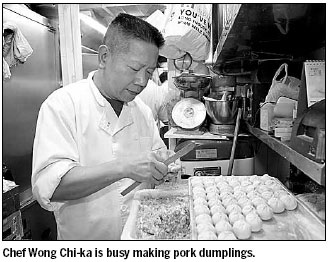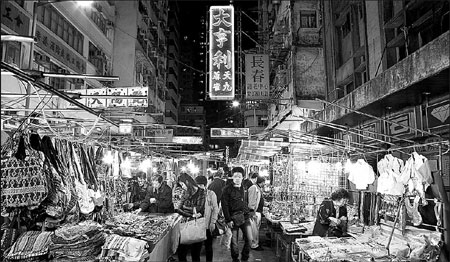Devouring 'the dark side'
Updated: 2013-10-20 08:14
By Donna Mah(China Daily)
|
|||||||||
A food walk through Hong Kong's 'dark side' proffers plenty for curious epicureans. Donna Mah puts her feet to the pavement to taste test the city's best.
Hong Kong is widely hailed as a food paradise where people can dine on an impressive number of cuisines on a range of budgets.
But outside foodies might find the prospects of discovering the best bites daunting, and a growing number are joining "food walks" in the city.
I recently participated in the Heifai Food Walk organized by Urban Discovery, which also runs Amazing Race-type scavenger hunts to help people discover Hong Kong's less touristy corners.
The Heifai Food Walk runs Tuesdays and Fridays from 6 to 10 pm. Our journey began with our guide, Edmond Lam, outside Jordon MTR subway station in Kowloon (also commonly referred to as "the dark side") and ended at Yau Ma Tei MTR subway station.
Our first stop was Wong Chi Ka (which translates as "the home of the king") where we had our starters - delicate xiaolongbao, cold shredded chicken on rice noodles with peanut sauce, and flaky turnip pastries.

At this cozy little shop with a small open kitchen, Edmond explains heifai means "move your chopsticks" - as in "let's eat!" When the host says heifai, the meal may begin.
A word of advice: Try everything but don't fill up at the first couple of restaurants or you won't be able to enjoy everything that's coming.
Our next stop was Mak Man Kee Noodle Shop. This small, simply decorated noodle shop is typical of this type of noodle joint in Hong Kong. The overall color scheme is white with handwritten menus (in Chinese) displayed on posters.
Seating is a bit cramped, so don't expect to linger over your meal. We had to wait a few minutes before we were able to grab a table, but the spicy and sweet shredded pork and noodles were worth the wait. This is one of those dishes that always reminds me of Hong Kong.
Edmond tells us Mak Man Kee's noodles are made with duck eggs instead of chicken eggs, making them slightly chewier.
We also had some deliciously fresh shrimp wontons in soup. The pig trotters on noodles is also a signature dish here, having been simmered until tender for about four hours, but we had to give this a miss as we wanted to be able to eat more at our next stop.
Next came the "food challenge" stop. There is the herbal teashop, Pak Po Tong, where we tried the 24-flavor tea and the turtle jelly.
"We try to give our clients an authentic experience of the local eating culture (in Hong Kong)," Edmond says.
"So my role is to explain the reason why Chinese people (eat particular foods) and help them understand local eating habits."
The second shop in the food challenge was a snake shop, Shek Wong Po, where we were asked to sample the thick snake soup and snake wine.
Edmond says about half the participants will try the food challenge items once he explains the health benefits divined by traditional medicine - whether they cleanse or nourish the body. However, the food walk's least popular dish is the turtle jelly because it tastes like medicine.
It was time for a stroll along the Temple Street night market to give us a bit of time before the next stop and to do a bit of souvenir shopping.

We also had our fortunes told by one of the many fortune-tellers who set up shop along the street each night. I was told I was not going to win any lottery jackpots and needed to get more rest. I can't say that either of these revelations were truly news to me, but it was good fun to "learn" about my future.
It was then time to eat at one of the oldest daipaidong ("big license" restaurants) on Temple Street, Hing Kee Restaurant.
Although immensely popular, we were able to get a table after a short wait because Edmond is a regular.
A few food walk favorites are clay pot minced beef on rice, clay pot Chinese sausage and chicken on rice, fried oyster pancake, and salted and chili-fried squid.
The dishes are all served piping hot and fresh from the stove. Be careful not to burn your fingers on the hot clay pots. The pots are cooked using small individual charcoal cookers, giving the dishes a distinctive flavor.
My favorite was the oyster pancake, which was served hot and crispy with tender, juicy baby oysters strewn throughout.
After all this food, there was still dessert to be eaten! We were offered a choice between two places.
Gourmet Dessert Cafe serves Western-style desserts while Yuen Kee Cha Zha serves Chinese after-dinner delights.
Unfortunately, I am not like many of my friends and do not have a separate stomach dedicated to sweets. Consequently, I didn't indulge in any of the desserts.
Still, I learned about Gourmet Dessert's most popular dishes: Baileys souffle, melted chocolate with ice cream and "burning snow mountain".
Yuen Kee Cha Zha's biggest movers are: Chazha, a sweet bean soup that can be served hot or cold; black sesame paste, another sweet soup made with ground roasted black sesame; and sweet glutinous rice and peanut dumplings.
Food walk guide Hiunam Wong tells us she usually takes foreigners on the walk, and they try to say the Cantonese words she teaches them. She, in turn, tries to say a few words in their languages.
"We all sound silly but (it's fun) and we have a good time."
That pretty well sums up this local food walk experience on the "dark side".
After all the food, fun and laughter, it was time to roll home.
Contact the writer at sundayed@chinadaily.com.cn.
|
The Temple Street night market is filled with souvenir shops and food daipaidong. Photos by Donna Mah / for China Daily |

(China Daily 10/20/2013 page15)
